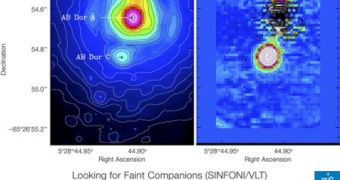Finding planets orbiting stars at great distances from our solar system is not an easy job, but there seems to be many of them out there, according to recent observations. And that's a great thing, since it's actually harder than finding a needle in a hay stack. It's more like looking for a firefly flying in front of a lighthouse.
Stars often have planets and maybe other, fainter, companions around them, but because these are outshone by the brighter star, special techniques must be used to detect them, without relying on optical telescopes.
Analyzing the spectra of the object can be equally difficult, because of the same glare of the star, but now a team of scientists and a new ESO imaging spectrograph are providing the tools for overcoming this hurdle, leading the way to new exciting discoveries.
Astronomer Niranjan Thatte and his colleagues developed a new method that relies on the location of the faint celestial body that never changes, instead of using the positions of most of the features associated with the host star and artifacts produced by the telescope and the instrument.
The problem with relying on the features of the object is the fact that they scale with wavelength, so if the image has an internal reflection of the star masquerading as a planet, this phantom planet will be in one location in the image when looking in red light, and another when looking in blue.
The advantage of this new technique is the fact that a real planet will stay in the same place no matter what color of light one examines; therefore, one can see what is scaling, subtract it, and be left with what is fixed, that is the target dim object.
Called "integral field spectrograph" the instrument used by ESO's Very Large Telescope, or SINFONI, was recently used to obtain spectra of real objects. As a result, astronomers obtained the first spectrum of an object that is free from the light given off by the brighter star and contains all the necessary information for a complete classification. "We applied our new technique to a puzzling very small stellar companion - about twice the size of Jupiter - known as AB Doradus C and the outcome was surprising,", says Thatte.
He was able to calculate a completely new temperature for the observed object and also changed some other previous results that some of the same scientists derived in 2005. "This is how science progresses," says Laird Close, leader of the science team. "New instruments lead to better techniques and measurements, which often lead to new results, and one must happily change course."

 14 DAY TRIAL //
14 DAY TRIAL //